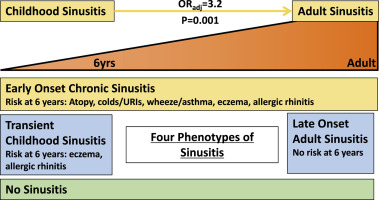Journal of Allergy and Clinical Immunology ( IF 11.4 ) Pub Date : 2018-02-21 , DOI: 10.1016/j.jaci.2017.11.052 Eugene H. Chang , Debra A. Stern , Amanda L. Willis , Stefano Guerra , Anne L. Wright , Fernando D. Martinez

|
Background
Chronic sinusitis is a commonly diagnosed condition in adults who frequently present with late-stage disease and irreversible changes to the sinus mucosa. Understanding the natural history of chronic sinusitis is critical in developing therapies designed to prevent or slow the progression of disease.
Objective
We sought to determine early life risk factors for adult sinusitis in a longitudinal cohort study (Tucson Children's Respiratory Study).
Methods
Physician-diagnosed sinusitis was reported at age 6. Adult sinusitis between 22 and 32 years was defined as self-reported sinusitis plus physician-ordered sinus radiologic films. Atopy was assessed by skin prick test. Individuals were grouped into 4 phenotypes: no sinusitis (n = 621), transient childhood sinusitis only (n = 57), late-onset adult sinusitis only (n = 68), and early onset chronic sinusitis (childhood and adult sinusitis, n = 26).
Results
Sinusitis was present in 10.8% of children and 12.2% of adults. Childhood sinusitis was the strongest independent risk factor for adult sinusitis (odds ratio = 4.2; 95% CI: 2.5-7.1; P < .0001; n = 772). Early onset chronic sinusitis was associated with increased serum IgE levels as early as at 9 months of age, atopy (assessed by skin prick test reactivity), childhood eczema and allergic rhinitis, frequent childhood colds, maternal asthma, and with increased prevalence of concurrent asthma. No association was found between late-onset adult sinusitis and any of the early life risk factors studied.
Conclusions
We identified an early onset chronic sinusitis phenotype associated with a predisposition to viral infections/colds in early life, allergies, and asthma. Elucidation of the molecular mechanisms for this phenotype may lead to future therapies to prevent the progression of the disease into adult sinusitis.
中文翻译:

慢性鼻窦炎的早期生命危险因素:一项纵向出生队列研究
背景
慢性鼻窦炎是成年人中的一种常见疾病,经常表现为晚期疾病和鼻黏膜不可逆转的变化。了解慢性鼻窦炎的自然病史对于开发旨在预防或延缓疾病进展的疗法至关重要。
客观的
我们试图通过一项纵向队列研究(图森儿童呼吸研究)确定成人鼻窦炎的早期生命危险因素。
方法
医师诊断为鼻窦炎的报告时间为6岁。成人鼻窦炎的定义为22岁至32岁之间的自我报告为鼻窦炎加上医生订购的鼻窦放射影像。通过皮肤点刺试验评估特应性。将个体分为4种表型:无鼻窦炎(n = 621),仅短暂性儿童鼻窦炎(n = 57),仅迟发性成人鼻窦炎(n = 68)和早发慢性鼻窦炎(儿童和成人鼻窦炎,n = 26)。
结果
鼻窦炎存在于10.8%的儿童和12.2%的成人中。儿童鼻窦炎是成人鼻窦炎的最强独立危险因素(几率= 4.2; 95%CI:2.5-7.1;P <.0001; n = 772)。早发性慢性鼻窦炎与早在9个月大时的血清IgE水平升高,特应性(通过皮肤点刺试验反应性评估),儿童湿疹和变应性鼻炎,儿童经常感冒,母亲哮喘以及并发哮喘的患病率增加相关。迟发性成人鼻窦炎与所研究的任何早期生命危险因素之间均未发现关联。
结论
我们确定了一种早期发作的慢性鼻窦炎表型,与易感性病毒感染/感冒,过敏和哮喘有关。阐明该表型的分子机制可能导致将来的治疗,以防止该疾病发展为成人鼻窦炎。











































 京公网安备 11010802027423号
京公网安备 11010802027423号